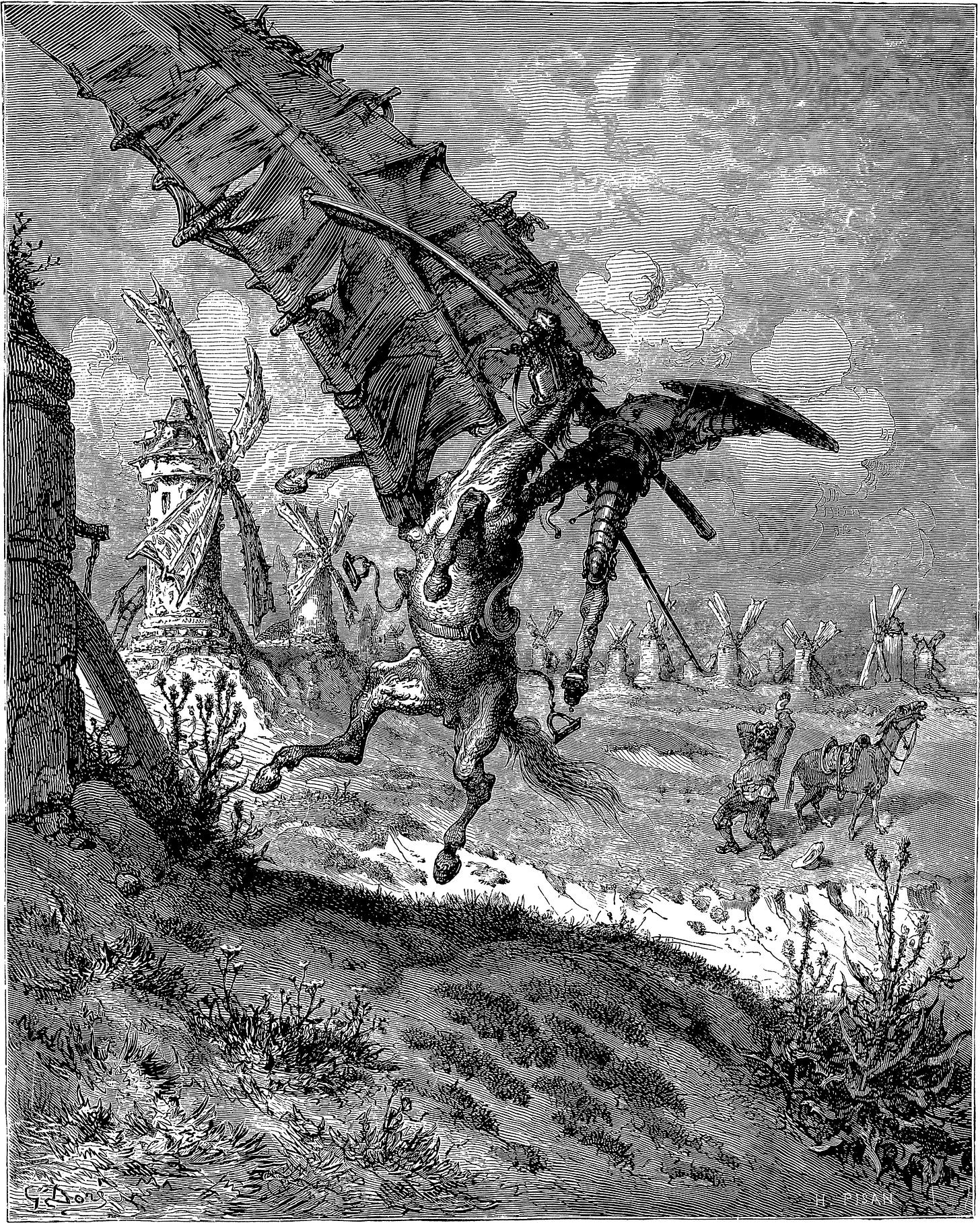Tilting At Windmills
Part II: The Counterintuitive Shape of Trader Development
Dear Practitioners,
We continue The Counterintuitive Shape of Trader Development with a diagnosis of why so many novice traders fail to break out. Much of this, I argue, lies in identity and in the lifelong conditioning that rewards theory over perception, knowing over seeing. Through the early careers of The Collector and The Warrior, we explore how they became Minimum Viable Traders: narrow, fast, fragile, yet capable of pivot and survival.
Part III turns to the problem of abundance—how too much choice and too little constraint undo the trader before they’ve even begun. It will consolidate the notion of the Minimum Viable Trader and set the stage for the next major phase: the transition toward the Always Viable Trader—and what it truly means to become one.
» Part III follows next week.
Last Week on ‘The Counterintuitive Shape of Trader Development’:
In Part I, we introduced the series through the essence of the problem: markets can only be navigated, not solved. Yet the novice must, paradoxically, ‘solve’ the immediate market environment just to launch—to become the Minimum Viable Trader. Start Narrow, Grow Wide opened with that contradiction: the siege mentality of doing whatever it takes to survive versus the open-ended navigation required to sustain a career. We outlined how constraints, inexperience, and limited runway can paradoxically enable focus, creativity, and early viability—the trader as start-up fighting for survival before learning to evolve.
»You can read Part I here:
Part II: Tilting At Windmills
What does a siege mentality look like? “Be up this month or you’re fired.” So went the ultimatum, in 2009, for the young Collector after two years of energy, dedication and yet deep account drawdown. He recounts his response to his predicament in Traders of Our Time:
“I said to [one veteran trader], where are you making money? I haven’t got time! That’s when you started to get the ‘Chicago PMI’ [Purchasing Managers’ Index] trade, where that trader and another were making amazing money. Four months later, it stopped working, yet it gave me enough to get off the ground.”
Enough is the Minimum Viable Trader (MVT) credo. Narrow is fast, but narrow is fragile. The path that launches you can break you; it is to drink from a weakly poisoned chalice. But with one experience, our young Collector captured the MVT’s lifecycle—launch, then pivot. The former has permitted the latter.
You’ll find this early career continuity in Traders: the ‘antagonism of learning and performing.’ Learning ‘mode’ reinforces beneficial behaviours, habits and practices. Yet this beneficial reinforcement for a learner becomes detrimental for a performer. It’s an adaptation issue. For example, the learner and performer should debrief and journal differently. But the learner continues the practice innocently because it has advanced their career. It worked! Why change it? To a learner, progress means doing more—gathering experience, accumulating knowledge, logging desk hours. The trap is that they don’t see that becoming a performer requires the opposite: doing less.
While this painful transformation of antagonistic habits, mentalities, and processes can’t be circumvented, Traders conceded there’s no principle for when a trader should transform. Too early is as lethal as too late, and the trader must decide. Often, they are forced to transform. The MVT is a continuity traceable in early careers that helps us review how many enduring traders made this transition. This should help newer traders make this judgment. Do you have enough?—the overgrown learner must be asked. That floor boss answered his own question and acted accordingly with the young Collector.
If the young Collector had built his identity or trading career on being a “PMI trader,” he wouldn’t have seen the year’s end. In other words, to launch but not pivot. Consider the post-Great Financial Crisis environment, which, as our trader explained, was laden with order flow anomalies. This allowed monetising the lowest hanging fruit in the most straightforward, minimum viable way:
“[Later in the year] I used to sit there all day with one lot in the DAX [German equity index]. I thought, I will sit here for hours, and if I can nick ten or twenty ticks out of the DAX… if I can make three to four hundred euros every day, that will be enough. It will get me going,” he said. “After banking two thousand euros a month later, a few other order flow trades started working. I threw everything else out, all I traded was this specific price action and data releases.”
This is the ‘T-shaped’ development of the young Collector, forced into a do-or-die MVT. Going deep into the PMI trade provided a runway: money, confidence, faith—not getting fired. Buying time increased his surface area for luck: new opportunities. The price ladder skills from the ‘PMI trade’ were transplanted to the DAX and other order flow trades. He’s recycled profitably, yet learning adjacently while being paid. In other words, he started narrowly and, without realising, began to grow widely. And what focus! I threw everything else out. These are the words of a learner mutating into a performer. Contrast this evolution against two years prior:
“I had no real style or understanding of what I was doing. I was doing everything… just a junkie, and I had so much energy for it, albeit misdirected… I just loved the idea of trading and the process.”
We recall R.G.’s diagnosis in Part I: “getting pulled in all directions.” The young Collector, through his love of the ‘game’ and energies, was an unbound learner, a hungry learner—a strength! By his second year, it became a liability because it prevented him and others from launching and becoming performers. In short, the floor boss’s ultimatum tamed his curiosity and unbound learning to start narrow, which then allows one to grow wide later.
The hungry learner often feels a sense of regression when discarding accumulated knowledge—a sunk cost. Perhaps to cut out an entire body of knowledge and experience, as the young Collector did. What about this whole playbook I’ve developed in the Stoxx? But that body can be dangerously fabricated. There’s always a “hidden curriculum”—unspoken lessons and assumptions shaping our thinking. These can be helpful or harmful, based on the current reality. From trader to floor, this hidden curriculum can teach, or reinforce rigidity, or stasis—solving!—and false causality. Or make believe that causality is linear. A vast topic, but for the novice, they’re liable to reinforce assumptions. This is seen in how novices create folders, file structures and categories in their journaling and debriefing tools ahead of their market experiences, which will prejudice them to what’s next. To ignore exceptional moments not as clues but as anomalies to be ignored. In that anomaly could be a new trade, and they are often the best.
The hungry learner must give way to the starving performer. To ask: do you want to get paid, or cling to your over-optimised ‘knowledge’ that can’t withstand the market’s current reality? The learner becomes a performer once they cut their learning ‘losses’—valued by effort and time spent, yet it allows their career to survive.
There is optimism. The jettisoned learning losses will either be recycled for later use or dissolved—sublimated—into tacit knowledge, freeing up conscious firepower for a holistic understanding and focus on what is decisive. Perhaps reaction against that early body of ‘knowledge’, ‘method, or ‘strategy’ provides clarity or influence to develop the trader. As we will explore later, it is learning that will decide the outcome of a multi-decade career. But launching is different from sustaining a trading career, and in this contradictory period, the MVT must jettison sentimentality from his sinking raft and hold onto necessities. Otherwise, they will sink into delusion.
Is Identity Delusion?

Seldom would you find a new trader devoid of love and energy for this domain, nor those curious and eager to learn and be the best. Yet, as the young Collector put it, you’d find many “so invested mentally and emotionally in becoming a trader.” Strengths become weaknesses. Here, the same traits can sustain a career but undermine its launch. Identity, or attempts to preserve it, hold back new traders from launching in fear of losing their identity. Getting fired.
While essential for new traders, staying in ‘learning mode’ for far too long, as explored in Traders, is detrimental because it’s too safe. Many become delusional, waving their lance at giants only to charge at windmills, to play the Knight-Errant rather than face the difficulty and danger of becoming one. They avoid the risk because their career can die—launch a real account, then fail—what then? After all these years! Better de-risk by practising on the simulator some more…
Others can make trading whatever they’d want it to be because the ‘strategy’ a novice has been constructing for years never faced real-life friction—full-blown hallucination. Sometimes, the status is better than the real thing, as seen on social media. The ‘real thing’ happened to our young Collector after two years of play, after the floor boss ultimatum. Forcing him from learner to performer:
“I was so incredibly focused. I knew that if I missed a tick, that could be the difference between surviving or not. I started capitalising on my momentum and consistency. I brought my account back from a loss of twenty-three thousand pounds to flat in three months.”
The young Collector maintained this focus and achieved many consecutive six-figure performances in the years that followed. However, this trader did not conflate his narrow, environment-dependent “scrappy trades”—in his words—with identity. Instead, he saw his skills as interchangeable rather than defining his career. This led many traders to wait for “the market to get good again” during years of low volatility and tight ranges, creating a radically different environment in the post-GFC world. Many remained MVTs without realising it, and the market’s rate of change reinforced this fragility—for so long in a stable environment—that they believed their experiences and skills qualified as ‘trading’. They had become such performers that it blinded them to learning—let alone adaptation—even when radical relearning was required. And it certainly was. If mentalities are reinforced by what the market can or can’t do, it becomes orthodoxy—‘common sense,’ then ossified as ‘knowledge.’ The meta-game becomes self-perpetuating.
The unbound “junkie” for learning and knowledge was tamed by creating an MVT through force. Yet, the young Collector transitioned into an always-viable trader because the learner never left him. Hence, he earned his alias in Traders of Our Time. We’ll revisit this difficult transition later.
Run ’n’ Gunnin’: The MVT as The Epistemological Mercenary
‘Knowledge’, as age and market experience reveal, becomes disconcerting as its fragility dawns upon the innocent. Facts, as teenagers discover, who are pulled screaming into the adult world, hopefully realise that facts do not equate to truth. Especially ‘T’-ruth. That is to evolve from the belief in the solidity of knowledge acquired in a schooling system. Note: system, meaning directed to one goal or purpose, and quantifiable outcome—pass your exams. Most modern schooling systems and derivatives are designed for semantic learning: “learning to know,” or: “just know it,”—it’s on the test tomorrow. This is a disservice to the streetwise—or forestwise, mountainwise, steppewise, desertwise—natural human aptitude for observation. This is perceptual learning—“learning to see.” Such aptitude gives way towards the authority of knowledge, method and theory rather than reality. Did you ever ask if there is more than one true scientific method? Perhaps this is our modern equivalent that was once damning to ask: Did you ever ask if there is more than one true God?
In our pursuit of knowledge, we’ve forgotten how to truly see, perceive, and observe. This has undermined our observational abilities and the depth of understanding we can achieve. Both Asymmetrist and Traders of Our Time emphasise the primacy of Observation. With The Razor, we discussed how a trader views the market through copied strategy—‘knowledge’—therefore has “contaminated” observation. This leads them to misapply this strategy on what should be treated as objective market phenomena: patterns. ‘Knowledge’ has supplanted observation, even though knowledge lags, while good observation reflects the current market environment. The enduring trader is always aware of the current market demands. The exceptional trader becomes so because of their ability to spot exceptional information which can only be based on their observational powers. The novice aiming to monetise our trading domain repeats the ritualised—‘learning to know’ in endless, subtle ways. They flounder from a gluttony for knowledge. Or they attempt to hedge ‘launch risk’—trading live, failing and ending their career—by charging at windmills.
But the observer is far from perfect. In our strange financial market world, the observer is both participant and entangled in the complex markets, as is the ‘observer effect’ in other domains. In the markets, attempting to answer the question changes it. Humans as observers are faulty too. Yet these are not excuses to replace our observation faculty, the root of all domains. So too for trading; more so for the MVT-novice.
Practitioners would point out that there’s no ‘Immaculate Novice’, conceived from nothing: no conception of markets or modern world—to start fresh. This doesn’t mean all ‘knowledge’, ‘method’ or ‘theory’ is to be avoided. The world wouldn’t exist without these, but it’s to question the glue that holds it together. Reaction against these things permits movement. It’s a call for method anarchism, to reject method conformity, because those in the latter confuse the map for the territory and never consider how, why, when the map was made. Such is the state of a school-factory upbringing that prioritises semantic over perceptual learning, and the novice-trader ill-prepared to deal with the market’s complexities. Generations have been trained as map-makers and not navigators. It also leads the novice-trader to accumulate ‘knowledge’ as a sacred total, because this is what they’ve always done in their first two decades of existence or longer. It then becomes easier to accept, and quickly defend, what has become ‘canon’ in certain circles. That is: knowledge, method, theory about what markets are, and how they can be monetised—or if they can be at all. Theory at the expense of reality. The MVT breaks the novice-trader out of this conditioning, transforming them into a method mercenary; always ready to blow it all up, restart and pivot.
We must restate this condition because it is so severe. Novices over-prepare and stay too long in ‘learning mode’. They should start with a handful, not a bagful, of knowledge, experiences, social learning, etc. Then launching will clarify what the MVT-Novice needs to learn to monetise what the market demands—ideally, no more. They must perform as lean as possible, work with their narrowness, and prioritise speed of monetisation. This handful will be repurposed and remade for market needs—stress-tested knowledge, ideas, and frameworks made significantly more useful for the MVT-novice. Experience and knowledge intertwined. Overtime they will grow widely, as within a performer lies a bound learner.
What is a memorable MVT example? Take the young Warrior’s story from Traders. He observed strange phenomena weeks into his first trading floor: when the Bund goes up, the S&P goes down, and vice versa. Later he’d learn this correlation was termed risk-on and risk-off, active due to a narrative and headlines he was oblivious to. But none of this was strictly needed for our young trader to quickly devise a way to grab a few ticks from this phenomenon. He mirrored The Razor’s advice: observe objective market phenomena (patterns), then monetise through custom, subjective strategy. Custom to creatively deal with his constraints. He didn’t conflate his career with these monetised achievements, or regard them as ‘skills’ or ‘strategy.’ Nor did he assume this was all trading; eventually recasting these developments into trading the news. His career too: ‘T’-Shaped’, monetised narrowly on correlation flows and grown into an immense repertoire of skills and experiences.
The young Warrior would observe and solidify with ‘knowledge’ that this correlation doesn’t happen all the time or in the same way. Then he’d lean on the collective ‘horizontal’ and ‘vertical’ knowledge and experiences from the trading floor. To borrow what he needed at the time: from veteran traders recounting their experiences during an extraordinary interest rate cut, to desk-mates trying to survive: the young Collector and the young Sphinx. What a method mercenary! The young Warrior is a product of a performer that learned to keep his learner bound, lucid, who would indeed one day charge at actual giants. But for all these minimum viable traders this was more than sufficient; it got them started.
The Next Part Has Been Published!»
We explore how abundance itself becomes a trap—when freedom without form erodes focus—and how constraint, paradoxically, builds the foundations for mastery. It’s the hinge between the Minimum Viable Trader and the Always Viable Trader.
Acknowledgements, Permissions & Disclaimer
Grateful acknowledgment to AXIA for granting access to their London trading floor and to observe and learn as “writer-in-residence.”
The photograph, provided by Axia Futures, is used with their permission, and they retain full ownership and copyright over the image.
Disclaimer: Do Not Do Stupid Financial Decisions. This Is Not A Game.




